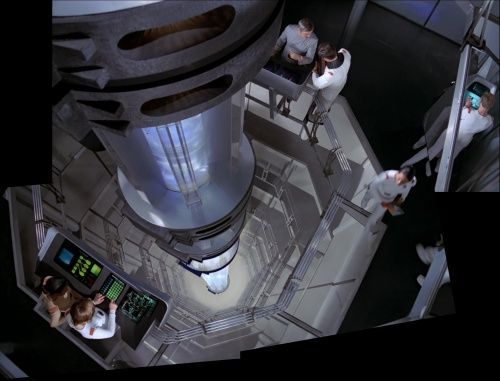
My English must be worse than I'd like to believe.
I only relied on Kimble's and Big Jim Slade's stern views of the saucer (diameter size figures supposedly undisputed) to arrive at a workable "real-life" width of the impulse engines' exhaust nozzles.
Next, I relied exclusively on the actual stern view images. It's easy to calculate the width of the skegs (and the dorsal in that area) based on the width of the impulse engines' exhaust nozzles.
And that's the head scratcher. So you relied on Kimble's and BJSlade's blueprints to derive a width for the impulse engine nozzles then you switch over to photographs with perspective distortion to derive a width of the skegs to get you a width of the dorsal.
Why didn't you just directly measure the width of the dorsal from the blueprints? Or only rely exclusively on the photos? Instead you've now made your analysis complicated with uncertainty from different and varying degrees of accuracy sources.
Oh and btw, the measured dorsal width of the DE Enterprise is 0.042 x 141.7m = 5.97m or 19.5'. Multiply for a 355m ship and that comes to 6.95m or 22.8'. It's in between the Kimble and BJS blueprints.
I am in the airport with a delay, looking for things to do, so I popped in. This may be letting out the magician's tricks but . . . It's all a matter of art.
I found conflicting information on the saucer diameter (among other things). Some gave it as 46-1/2". Others gave it as 46-3/4". One person told me that it was supposed to be 46-1/2" and overshot in construction. In any event, I tried both and I ended up using 46-3/4" (going from memory here--but I know its the 3/4 not 1/2).
The actual width of the impulse engine as I have it is less scientific than you might imagine. There is a circle of an even radius at an even offset with a tangent line to a point an at even offsets that defines the basic shape.
The final width come from chopping the block at various angles. The width comes from the chopping. That becomes one of the areas of odd measurement. The angles come from a lot of eyeballing and trial-and-error. I have the advantage of doing this in 3D so I can see the effect different changes have. I know that I have done some tweaking of those angles since the first version of the plans.
I don't have/never had access to the original model. There are basic measurements of a lot of things (e.g. length, saucer diameter, warp engine length, diameter, engineering hull length) that I use. But the sources often conflict and how accurate are they? I use the length 100". Is the 100-inch studio model exactly 100"?--we work within our limitations.
I base everything off of round sizes and offsets. In most cases I go no lower than 1/16" (in a few places 1/32"). For very small details (e.g. grid lines), I might go down to multiples of 0.01". Lengths defined by angles do have odd values.
It would be silly for me to make a part precisely 11.00274" wide when I am largely working off of photographs.
The bottom line, is all of this is done to be close enough for government work.
Furthermore, the raster images give up a lot of detail and accuracy. There are things that look like angles in the images that come out as curves when printed full size.
I have generated a new set of plans. The only dramatic difference is in the hangar door. However, this one contains measurements of all kinds of things to take the guess work out. It also expands to 15 sheets (from 8).



 My English must be worse than I'd like to believe.
My English must be worse than I'd like to believe.
 o noon/pm
o noon/pm 